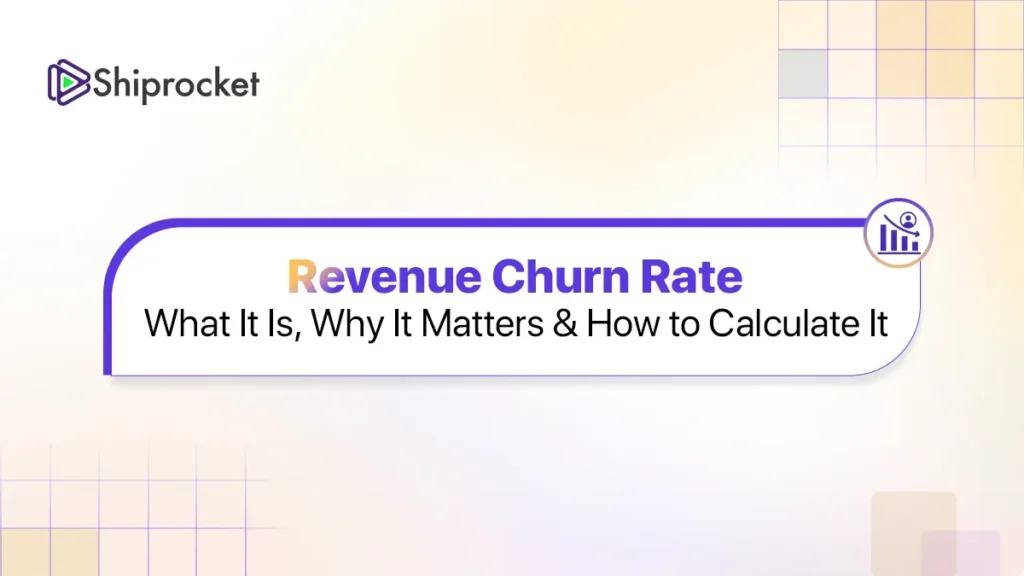- Customer Churn Explained
- Understanding Customer Churn Rate
- Customer Churn Rate Example
- Churn Rate and Growth Rate: Key Differences
- The Benefits and Drawbacks of Customer Churn Rate
- Calculating Customer Churn Rate: The Formula
- Methods for Calculating Customer Churn Rate
- Key Considerations When Calculating Customer Churn
- The Importance of Simplifying Customer Churn Rate Calculations
- 7 Possible Challenges in Calculating and Understanding Customer Churn Rate
- What Steps to Take After Analysing Your Customer Churn Rate?
- Strategies for Minimising Customer Churn
- Effective Methods for Monitoring Churn Rate
- Revenue Churn: Key Concepts
- Revenue Churn Rate Explained
- Calculating Revenue Churn Rate
- Customer Churn Rate and Revenue Churn Rate: The Contrasts
- Conclusion
The churn rate is an important metric for businesses, particularly those relying on subscription-based models. It measures the percentage of customers who leave within a specific period, directly impacting revenue.
Tracking churn helps businesses understand customer satisfaction, the value customers place on services, and overall business performance. Although it seems simple to calculate churn rates, its real-world application can get complicated.
Simplifying this metric helps businesses focus on measures and steps to improve consumer retention and drive revenue. Get essential insights on the churn rate and explore practical methods for calculating and using it effectively.

Customer Churn Explained
Customer churn describes the cycle of customers leaving after their initial purchase instead of returning. It’s natural for businesses to experience customer turnover, regardless of the quality of their services or products. A higher eCommerce churn rate usually indicates concerns about customer retention.
When customers buy once and don’t return, it can affect overall growth, primarily if the business relies on repeat purchases. For companies aiming to retain customers, tracking churn becomes valuable. It helps assess if marketing efforts are effective and whether customers are satisfied with their experience.
Understanding Customer Churn Rate
Customer churn rate measures how many customers stop using a service or buying products within a set period, like a month or year. Businesses track this rate to understand the number of customers they lose and how it impacts their growth.
For a company to grow, it needs to gain more customers than it loses. A “good” churn rate depends on the industry, as each sector has its acceptable rate. While no business has a zero churn rate, lower rates are generally better, improving customer retention rates. Comparing a company’s churn rate with industry averages helps determine if it is reasonable or concerning.
A high churn rate suggests the business is losing too many customers, which could point to issues like unsatisfactory service, product problems, or poor customer support. This means that a company needs to improve its offerings to keep customers engaged and satisfied.
Customer Churn Rate Example
Customer churn rate varies widely across different sectors, with each facing unique challenges. Below are some churn rate examples.
eCommerce Churn Rate
eCommerce brands often see high churn rates, with averages reaching between 70 and 80%. The wide availability of options encourages consumers to switch between brands, so businesses must work to keep customers engaged.
SaaS Churn Rate
The churn rate is essential for SaaS companies, primarily since these businesses depend heavily on subscription renewals. The industry median churn rate is about 14%, which SaaS firms should aim to stay below. For example, Netflix typically has a low churn rate but saw it rise to 3.3% in March 2022 after a price increase.
Logistics Churn Rate
Companies in this industry usually have a churn rate of 40%. High customer turnover often results from the sector’s operational complexities. To counter this, logistics businesses must focus on customer retention to maintain steady orders.
Churn Rate and Growth Rate: Key Differences
Churn and growth rates are crucial metrics that provide insights into a company’s performance and customer base.
- The eCommerce churn rate indicates the segment of consumers who stop buying a product or service over a specific timeframe. The growth rate, in contrast, reflects the number of new customers joining.
- When the churn rate is high, it indicates that more customers are leaving, which can harm the business if not managed properly. A higher growth rate suggests a healthy business that consistently attracts new customers, which helps drive revenue.
- Tracking this is vital to assess if customer retention needs improvement. Comparing growth with churn gives an accurate picture of customer acquisition success.
The Benefits and Drawbacks of Customer Churn Rate
Here are some critical points on the benefits and drawbacks:
Benefits:
- Shows how effectively a company keeps its customers, highlighting service quality and value.
- It helps identify customer service, product quality, or pricing issues when the churn rate rises over time.
- This can prompt the company to address the root causes of customer loss, potentially saving money, as retaining customers costs less than acquiring new ones.
- Allows comparison with industry standards, giving insight into the competitive scenario.
Drawbacks:
- It doesn’t distinguish between long-term and new customers, which can skew insights on customer satisfaction.
- Fails to factor in different business stages, such as startups versus established companies, making comparisons less accurate.
- Overlooks reasons behind churn, like one-time promotions that may attract short-term customers.
Calculating Customer Churn Rate: The Formula
You can use this churn rate formula to calculate the rate:
Customer Churn Rate = (Total Customers Lost in the Period / Total Customers in the Period) x 100
This metric can be tracked monthly, quarterly, or annually, depending on your needs. A monthly churn rate shows short-term trends, while an annual rate helps you see overall customer retention.
To apply this, first decide how you’ll count your customer numbers—some companies use the beginning of the month’s customer count, while others calculate based on the end of the month or an average. This choice can affect churn results, especially if you gain or lose many customers.
For instance, if a business started the month with 1000 customers and ended with 900, the churn rate would be 10%. This method only measures the loss of existing customers and excludes new customer acquisitions, focusing on customer loyalty.
Methods for Calculating Customer Churn Rate
There are multiple ways to calculate churn rates, each applicable in different contexts.
Simple Churn Rate Calculation
The simplest churn rate formula calculates the rate by dividing the number of customers lost by the initial customer count for the period. For example, if a company started with 10,000 customers and lost 500, the churn rate would be 5%. This quick calculation can become less accurate during periods of high customer growth, as adding more customers can lower the churn rate, even if customer losses remain constant.
Adjusted Churn Rate
This method calculates churn using the average customer count across the period. By averaging the beginning and ending customer numbers, this method stabilises the churn rate, providing a clearer view of customer retention during periods of growth. However, the adjusted churn rate can produce varied results depending on the period chosen, like monthly versus quarterly calculations.
Predictive Churn Rate
Predictive churn incorporates future data to estimate the rate of customer loss. For instance, a company could track how many customers are active at the start of one month and inactive by the next. This approach forecasts potential churn, helping businesses plan resources, though it requires waiting for future data, which may delay insights.
Cohort Analysis Churn Rate
Cohort analysis separates your clients into groups based on their signup date, tracking each cohort’s behaviour over time. For instance, if 1,000 customers joined in January and 100 left by March, the cohort churn rate would be 10%. This approach is especially valuable for understanding long-term retention trends across customer types or acquisition channels.
Key Considerations When Calculating Customer Churn
Calculating customer churn rate requires a closer look at factors affecting why and how customers leave. Here are key points to consider.
- B2B Vs. B2C Differences: B2B companies often serve niche markets with specialised needs, leading to lower churn rates as clients commit to long-term, high-value contracts. B2C businesses, dealing with a wider audience and more competition, face higher churn since consumers’ interests frequently shift and competition is intense.
- Intentional vs. Unintentional Churn: Not all churn is intentional. Sometimes, customers leave due to issues like expired credit cards or declined payments without meaning to cancel. This “involuntary churn” is the opposite of “voluntary churn,” which occurs when users voluntarily discontinue using a service.
- Pre-Churn vs. Post-Churn Interventions: Identifying customers about to leave before they leave can reduce churn. To retain customers, offer top support or payment recovery options. The customers who have already left can be encouraged to return via targeted incentives, such as discounts.
The Importance of Simplifying Customer Churn Rate Calculations
Keeping customer churn calculations simple offers a clearer foundation for further insights. Here’s why a simple approach matters.
- Easy to Understand: Simplifying churn rate calculations means anyone on your team can easily understand the metric. Complex formulas can lead to confusion, hindering effective action.
- Consistent Comparisons: Over-complicating the churn rate with too many variables makes it challenging to compare across different periods. A simple approach allows you to track changes over time consistently, revealing trends that help you make better decisions.
- Foundation for Insights: With a basic calculation, you have a clear view of what’s included—and what isn’t—in your churn data. This method gives you the freedom to analyse different patterns or cohorts without having to re-examine the formula each time.
7 Possible Challenges in Calculating and Understanding Customer Churn Rate
Here are seven issues that may arise while calculating churn rates:
1. Defining Customer Counts Correctly: Determining the total number of customers in a period, such as a month, can be tricky since new signups and cancellations constantly alter this figure. The churn rate may appear inaccurate if new customers comprise a large part of the base.
2. Deciding the Moment of Churn: A customer’s churn can vary by definition, either at cancellation or when their subscription ends without renewal. Different interpretations lead to inconsistent churn tracking and skew the current churn rate.
3. Small Sample Sizes: Churn percentages can shift significantly with smaller datasets. Early growth phases can make churn appear higher or lower than reality, complicating monthly comparisons.
4. Varying Time Frames: Churn can look different across timeframes—weekly, monthly, or annually. The same data may reveal different insights if viewed in one period versus another.
5. Customer Segment Differences: Various customer groups, like individual consumers versus enterprises, tend to have different churn patterns. Aggregating these rates can mask actual churn trends in specific segments.
6. Seasonal Variations: Churn rates may fluctuate with predictable cycles for seasonal businesses, making it challenging to interpret churn without analysing multiple cycles.
7. Consistent Calculations: Different methods across periods can make unreliable comparisons. Standardising calculation methods helps track churn accurately over time.
What Steps to Take After Analysing Your Customer Churn Rate?
Once you’ve analysed your customer churn rate, you can take these practical steps:
- Identify Reasons for Churn: To reduce customer churn, start by understanding the reason behind it. Collect feedback from past customers through surveys or interviews to learn the factors that made them leave. This feedback can guide improvements to retain future customers.
- Target the Right Audience: Customers who are not well-matched with your product are more likely to leave. Focus on reaching customers who need what you provide and create resources like blogs, guides, or emails to help them use the product effectively.
- Signs of Disengagement: Pay attention to signs a customer might be unhappy, like infrequent use or shorter session times. With these indications, you may provide support before things get out of hand.
Strategies for Minimising Customer Churn
Reducing customer churn is a crucial focus for businesses, and several strategies can help retain customers effectively.
- Improve Customer Service: Use your churn analysis to understand why customers leave and where your service can improve. By addressing any common issues, you’ll create a more supportive experience for future customers.
- Onboarding Process: Prevent early churn by creating a welcoming and thorough onboarding process. Consider personalised welcome emails, one-on-one sessions, and online guides that help customers get the best from your product.
- Proactive Communication: Reach out to customers regularly to build strong relationships. Share helpful content and keep them informed about any issues. Proactive communication builds trust and indicates that you care about their experience.
Effective Methods for Monitoring Churn Rate
Monitoring the churn rate effectively is key to improving customer retention.
- Set a Time Frame: Choose if you want to track churn on a rolling basis or for specified periods. Regular tracking gives a clearer picture of trends and helps respond promptly to changes.
- Define Your Churn Metric: Identify the churn type that matters most to your business, such as standard churn or revenue churn. This focus helps in setting clear goals and taking targeted actions for improvement.
- Use Customer Experience Tools: Utilise tools like customer experience software to monitor customer feedback and loyalty. Tracking customer satisfaction alongside churn can reveal patterns that need attention.
Revenue Churn: Key Concepts
Revenue churn refers to the loss in monthly recurring revenue (MRR) from existing customers who cancel their subscriptions. This measure highlights the percentage of revenue a company loses over a specific period. It is especially relevant for software-as-a-service (SaaS) or subscription-driven businesses, where retaining revenue is crucial to growth.
Revenue Churn Rate Explained

The revenue churn rate measures how much revenue a business loses due to customer cancellations or downgrades within a set period. A high revenue churn rate suggests that customers may not find enough value in the product or service or that the company’s retention efforts may need attention.
In many cases, this loss can be classified as revenue leakage, where recurring earnings quietly slip away due to customer downgrades, expired payment methods, or unnoticed cancellations. When revenue decreases due to churn, it can strain financial stability and affect growth. By analysing revenue churn, businesses can gain insights into customer preferences, pinpointing areas for improvement in service quality and product features.
Calculating Revenue Churn Rate
To calculate churn rates, identify how much revenue was lost due to customer churn over a specific time frame. Then, determine the total revenue generated during that same period.
For example, if your business brought in 1 million in a month but lost 100,000 from customers cancelling, the formula would look like this:
- Revenue Churn Rate = (Total Lost Revenue / Total Revenue) x 100
- Applying the churn rate example: (100,000 ÷ 1,000,000) x 100
This equals a 10% churn rate, showing that 10% of your revenue was lost due to cancellations.
Customer Churn Rate and Revenue Churn Rate: The Contrasts
Customer churn rate and revenue churn rate are two key metrics that, though connected, measure different aspects of customer loss. The customer churn rate shows the percentage of consumers who stop using a service within a given period. In contrast, the revenue churn rate gauges the percentage of revenue lost due to these customers, which can also include revenue dips from downgrades.
A high customer churn rate alongside a low revenue churn rate suggests that while some customers leave, they may only represent lower-tier accounts, leaving overall revenue less affected. However, if revenue churn is high while customer churn is low, it may signal the loss of larger, more profitable customers.
Conclusion
A company’s churn rate reveals valuable insights about customer loyalty and overall business performance. Monitoring this rate helps identify whether product quality and customer service meet expectations or require improvement. This insight aids businesses in maintaining steady growth by better managing customer needs.
Using eCommerce shipping and scaling platforms like Shiprocket, you can better manage customer interactions, inventory, and sales, creating smoother operations that can help lower churn.







